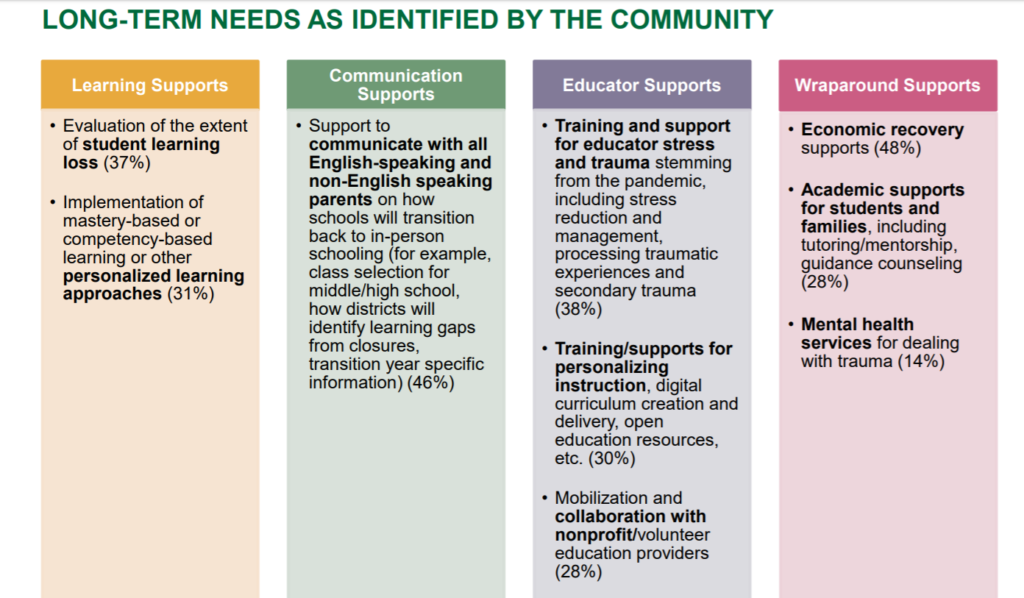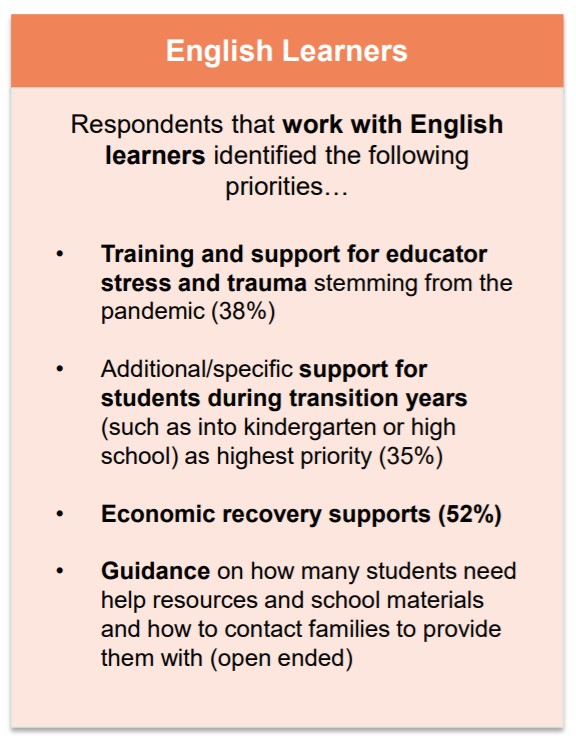What Have We Heard?
In April 2020, Rodel issued a survey asking respondents to prioritize the immediate, short-term needs related to COVID-19 and the longer-term needs for when students and teachers return to school. As our previous blog summarized, the 859 respondents, most of whom were parents and educators, cited a range of education needs including from Wi-Fi, parent supports, mental health, clear communication, and learning materials.

Furthermore, 52% of survey respondents indicated that they represent, serve, or care for English Learners/students who speak a language other than English. The results support what members of the Delaware Hispanic Commission Education subcommittee have shared at its last two monthly meetings.
In addition to the general education needs for all students listed above, we heard that English learners specifically need:
- Access to certified English learner teachers, programs, tutors, and translator services
- Access to an adaptation of online/printed materials, programs, and learning management system, in both English and the user’s native language
- Parent support including translation, interpreter assistance, technological assistance, training on how to help students learn, such as:
- Translation and ‘drop in’ type virtual Q&A sessions with qualified staff (not necessarily their teacher) to answer their questions
- Help managing learning for families with more than one child
- Support to communicate with all English-speaking and non-English speaking parents on how schools will transition back to in-person schooling, i.e. identifying learning gaps, transition year info

Where To Go For Answers To Frequently Asked Questions
During our Delaware Hispanic Commission Education Committee meetings, members of the community have asked questions about the current status of education for ELs.
Q1: What are districts and charters doing now to serve ELs?
- Has each district and charter published guidance on how English learner students will receive academic instruction?
- Have they published guidance on how they will receive their English language services remotely?
- Is this guidance accessible in multiple languages?
- Does it accommodate families without Wi-Fi?
- Has each district and charter stated an intention to translate all materials including any instructions for using technology for remote learning?
- Has each district and charter made interpreter and/or translation services available for parents and an opportunity to ask questions?
- How are schools handing evaluating, exiting, and entering English Learner students?
- What expectations/requirements are there for communications with English Learner families?
A1: Some answers to the questions above can be found online in the following links, but you can ask questions of your individual school, charter, or district
Q2: What comes next?
- What will happen in the fall or when students return to school?
- How will we ensure equitable access to internet?
- How will districts and charters evaluate learning loss for English learner students?
- How will districts and charters support mental health and wellness needs during the transitions? How will districts and charters prioritize cultural competencies; social and emotional learning?
- How will districts and charters support kindergarten registration?
- Can we ensure some level of uniformity/best practice in how schools are providing services, instruction, and communication for ELs and their families?
- How can I help?
A2: To help and be part of the discussion…
What resources exist to address the needs of ELs, their families, and educators?
The links below include suggestions from the Delaware Hispanic Commission Education Subcommittee.
Wi-Fi/Broadband Infrastructure
Family and educator communication tools
Educator tools to meet students’ specific learning needs
Other
- The Colorín Colorado website has numerous resources for ELL and Multilingual families, educators and administrators, during the COVID-19 pandemic available in English and Spanish.
- Education Trust: A P-12 Education Agenda in Response to COVID-19, which includes recommendations for school districts in allocating local, state, and federal resources to ensure all students have access to high-quality learning.

